Crustaceans
Crustaceans are invertebrate aquatic animals, that is, that do NOT possess the internal skeleton, but protect themselves through a TYPICAL armor called exoskeleton or carapace which circumscribes them in the group of Arthropods .

The crustaceans used in human nutrition are the Decapods, which further differentiate into: macruri, brachiuri and stomatopodi; below we will analyze in more detail those most consumed in feeding Italians (and others).
NB . The origin of the crustaceans is not always synonymous with greater consumption among the local population because, thanks (or rather ... A CAUSE) of fishing and export, the use of foreign products is now part of the daily diet.
Crustacean chemistry
Fat and Cholesterol Content
Contrary to what many think, crustaceans are foods with a low content of energy fats (triglycerides); what makes them less suitable in the diet of obese subjects or with metabolic complications (which have a greater tendency to atherogenesis) is the high cholesterol content.
It is true that they contain a good ration of polyunsaturated fatty acids (PUFA) and an excellent ratio between omega3 and omega6 (essential fatty acids - AGE), but this is not enough to justify food abuse in pathological conditions such as hypercholesterolemia, or worse, the metabolic syndrome.
NB. Some sea crustaceans have a fairly high sodium content, such as to make them inadvisable in the ordinary diet of those suffering from hypertension.
Positives
However, crustaceans also have positive nutritional characteristics: some of them are rich in iron, others in calcium, thiamine (vit. B1), riboflavin (vit. B2), niacin (vit. PP) and (red ones) of Astaxanthin, a strongly anti-ositid pro-vitamin A.
Unlike most animal products (with few exceptions), crustaceans contain an energy portion of available carbohydrates (0.5% of kcal TOT) and, exclusively, another of sugars NOT available: chitin ; this is an OMO-polysaccharide consisting of long chains of acetyl-glucosamine (a derivative of glucose) also present in the carapace of insects.
Unlike meat and fish, shellfish proteins contain more arginine than creatine.
Nutritional values of some crustaceans
| Nutritional values | Macruri | Brachiuri | Stomatopoda | |||
| Lobster | Lobster | prawn | Shrimp | Crab | Canocchia | |
| Water (g) | 80.95 | 82.24 | 79.91 | 74.91 | 79.57 | 80 |
| Energy (kcal) | 77 | 77 | 101 | 101 | 84 | 69 |
| Carbohydrates (g) | 0 | 0 | 9:13 | 9:13 | 0 | 2.3 |
| Proteins (g) | 16:52 | 15.97 | 12:39 | 12:39 | 18:29 | 13.6 |
| Lipids (g) | 0.75 | 0.95 | 1:47 | 1:47 | 0.6 | 0.6 |
| PUFA (g) | 0296 | 0293 | 0.75 | 0.75 | 00:13 | - |
| Cholesterol (mg) | 127 | 114 | 36 | 36 | 42 | 85 |
| Thiamine (mg) | 00:02 | 00:07 | 0024 | 0024 | 0043 | - |
| Riboflavin (mg) | 0014 | 0032 | 0034 | 0034 | 0043 | - |
| Niacin (mg) | 1, 591 | 2, 208 | 00:17 | 00:17 | 1.1 | - |
| Sodium (mg) | 423 | 58 | 705 | 705 | 836 | - |
| Iron (mg) | 00:26 | 0.84 | 0.6 | 4.3 | 00:59 | - |
| Calcium (mg) | 84 | 27 | 19 | 19 | 46 | - |
Practical aspects
As many readers will already know, the shelf life of crustaceans is more limited than that of meat; this is attributable both to the high content of free amino acids, which make the food significantly more susceptible to micro-organisms that release nitrogen (N), but above all to the rapid alterations of its ENZYMATIC OWN (which, however, contrary to the previous mechanism, although increasing the stench of ammonia, does not compromise its healthiness).
Crustaceans and diverticulosis
Another aspect to consider is the relevance or not of the ingestion of the carapace; some small crustaceans (such as shrimp) and all the molecules (crustaceans that have just lost their carapace and are developing a new one) can be eaten whole and not shelled; in this regard, we recall that in subjects suffering from diverticulosis, the possible insinuation of a fragment of carapace (albeit microscopic or soft) inside a diverticulum can ignite it, easily evolving into diverticulitis. In diverticulosis it is strongly advised against eating whole crustaceans without peeling them.
How many times a week?
Shellfish are foods with discrete nutritional properties and are a valid alternative to the usual products of animal origin; however, by virtue of their tendency to retain the sodium of sea water and the often significant concentration of cholesterol, it is recommended a "selective" consumption (of the most suitable species) and in any case infrequent or limited to a maximum of 1-2 weekly servings.
Shrimp Bisque (Crustacean Comic)
X Problems with video playback? Reload from YouTube Go to Video Page Go to Video Recipes Section Watch the video on youtubeBibliography:
- Edible animals of the Italian seas - A. Palombi, M. Santarelli - pag 364
- Food Microbiology - JM Jay, MJ Loaessner, DA Golden - Springer - 126-127



